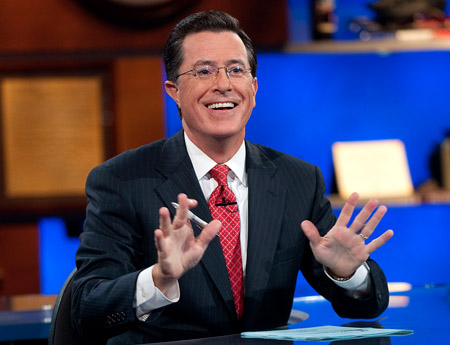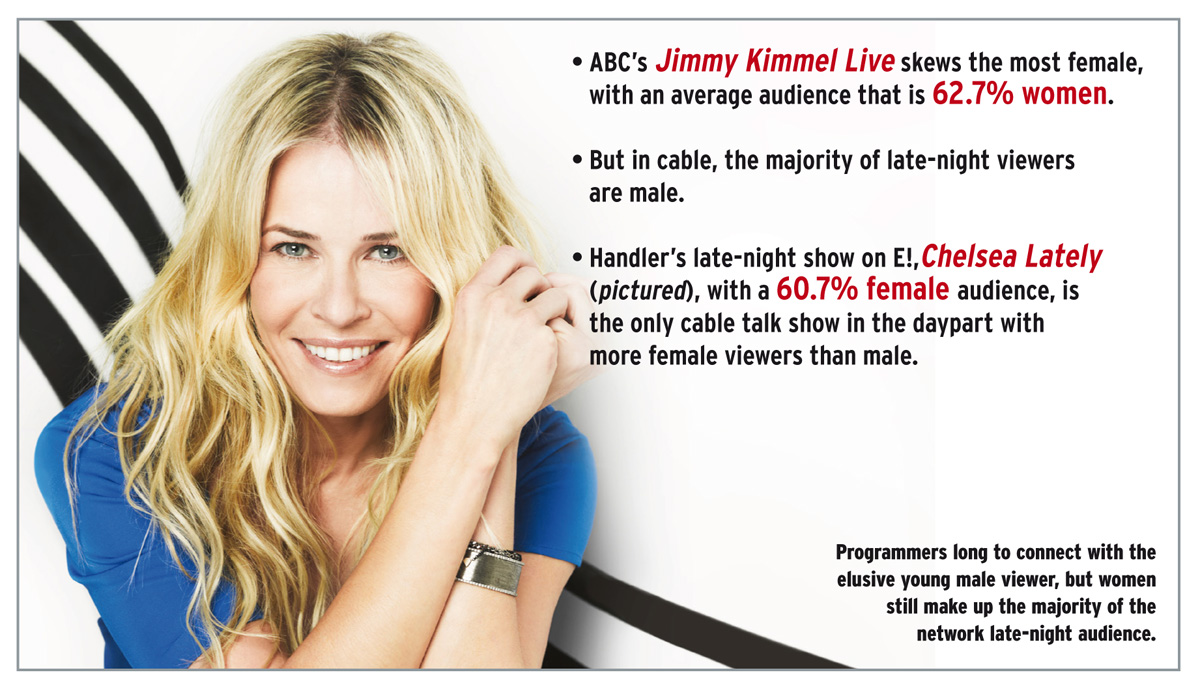Sex Appeal

CBS’ announcement April 10 that Stephen Colbert of Comedy Central’s The Colbert Report will take over for David Letterman as Late Show host in 2015 was widely praised in the press and social media. But it also bolstered the dominance of white men behind the desks of late-night shows—something network executives seemed sensitive to as they rolled out their succession plan. CBS Entertainment chairman Nina Tassler told B&C on the day of the announcement, “As a broadcast network, you have to look at the diversity issue across the full spectrum of the schedule. I think you look at every one of our dayparts, and we have diversity across the entire schedule.” CBS Corp. CEO Leslie Moonves told Bloomberg News that the 12:35 a.m. time slot—currently held by Craig Ferguson’s The Late Late Show—is “up in the air” and that “a woman would be great in late night.”
Ferguson’s contract is set to expire next year. Comedy Central, meanwhile, must plan to fill a Colbert-shaped hole at 11:30 p.m. So opportunities to diversify late night remain. But if a new female-hosted show is to become more than a hypothetical, it will require a break not just with tradition but also strategic thinking about late-night audiences.
“The target audiences for these shows are all young, white males, so basically the hosts that you’re seeing are just slightly older iterations of the target audience they’re looking for,” said Eric Deggans, television critic for NPR and author of the book Race Baiter: How the Media Wields Dangerous Words to Divide a Nation. “So you combine the fact that you’ve always had white males in these jobs and the fact that the target audience is young white males, and that produces a lot of inertia in the system.”
Ladies First
While programming executives may long to connect with young men, women make up the majority of the current network late-night audience. Among the five network late-night talk shows, ABC’s Jimmy Kimmel Live skews the most female. From Feb. 17—the date of Jimmy Fallon’s first episode as host of NBC’s The Tonight Show—through April 13, Kimmel’s average audience was 62.7% women. Ferguson skewed the least female, at 53.2%. Letterman’s audience was 55.6% female.
On cable, the demographics are reversed. The audience for TBS’ Conan was only 44.7% female. Colbert’s audience was overwhelmingly male—only 38.7% women, within half a percentage point of his lead-in, The Daily Show With Jon Stewart. The only femaleskewing late-night talker on cable was also the only one hosted by a woman. E!’s Chelsea Lately, starring Chelsea Handler—who has publicly feuded with her network and is expected to leave when her contract runs out at the end of this year—delivered an audience that was 60.7% female.

Money Men
Broadcasting & Cable Newsletter
The smarter way to stay on top of broadcasting and cable industry. Sign up below
From an advertising perspective, CBS may have an incentive to pursue a host at 12:35 a.m. who, like Colbert, is a proven draw among men.
“The networks already are attracting a sizeable female audience compared to males,” said Brad Adgate, senior VP of research at Horizon Media. “Ideally, you want a 50/50 split by gender—[it’s] better to get more advertisers.”
Adgate added that Comedy Central “would probably be more inclined to pick a female comedy host than CBS,” pointing to a deep bench that includes The Daily Show’s female correspondents as well as Amy Schumer, whose primetime sketch show, Inside Amy Schumer, drew 1.3 million live-plus-same-day viewers for its season-two premiere on April 1.
Among the other established female comics that could be considered for a late-night slot are Aisha Tyler, who cohosts CBS daytime show The Talk and hosts improv series Whose Line Is It Anyway? on the CW; and Abbi Jacobson and Ilana Glazer of Comedy Central’s primetime series Broad City.
“There’s room for emerging forms of diversity in late-night television,” said Lawrence Epstein, professor at Drexel University’s Westphal College of Media Arts & Design. “It may just, as so many things have in recent years, start on cable and work its way onto broadcast.”
Public pressure to diversify late night could help motivate change. Madeleine Smithberg, cocreator and former executive producer of The Daily Show, notes that television remains an industry dominated by decision-makers who are white and male. But that doesn’t mean that a new female host won’t soon join the late-night ranks.
“I think the good thing about these dudes is that because we live in a world that seems so much like junior high school, peer pressure is a really strong motivator,” she said. “And I think if peer pressure is strong enough, they may do it just to make us shut up.”
